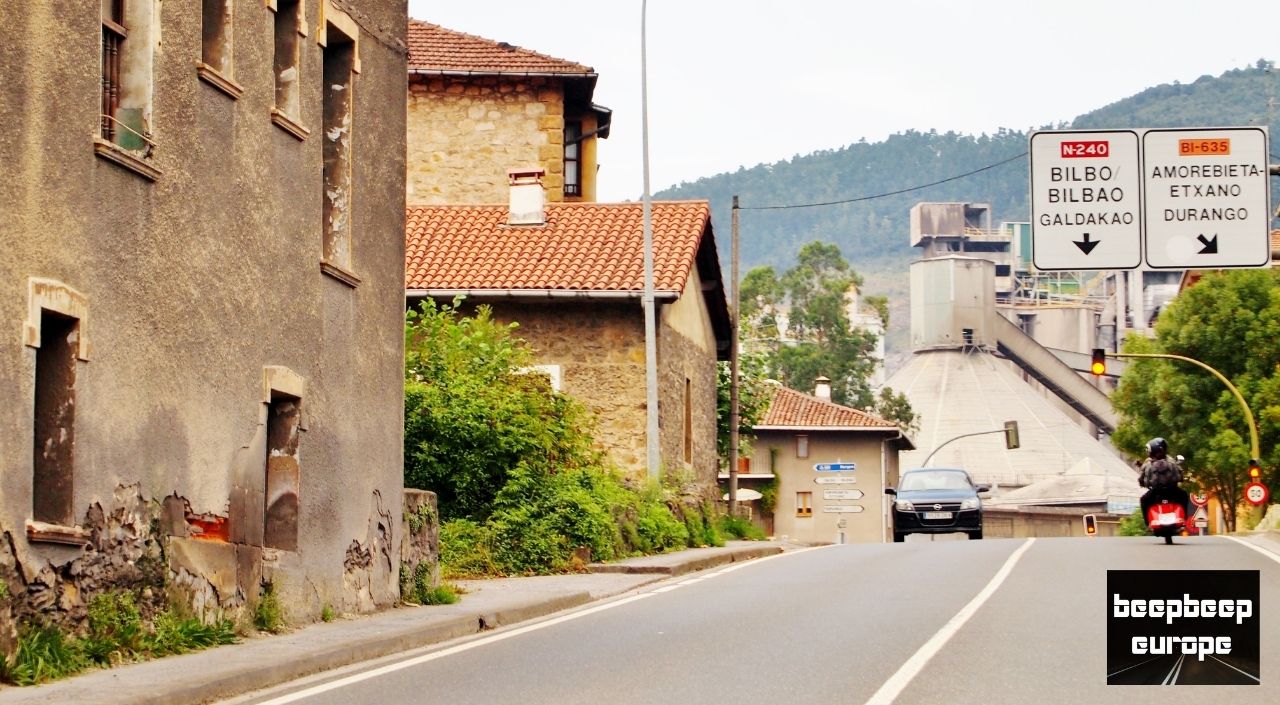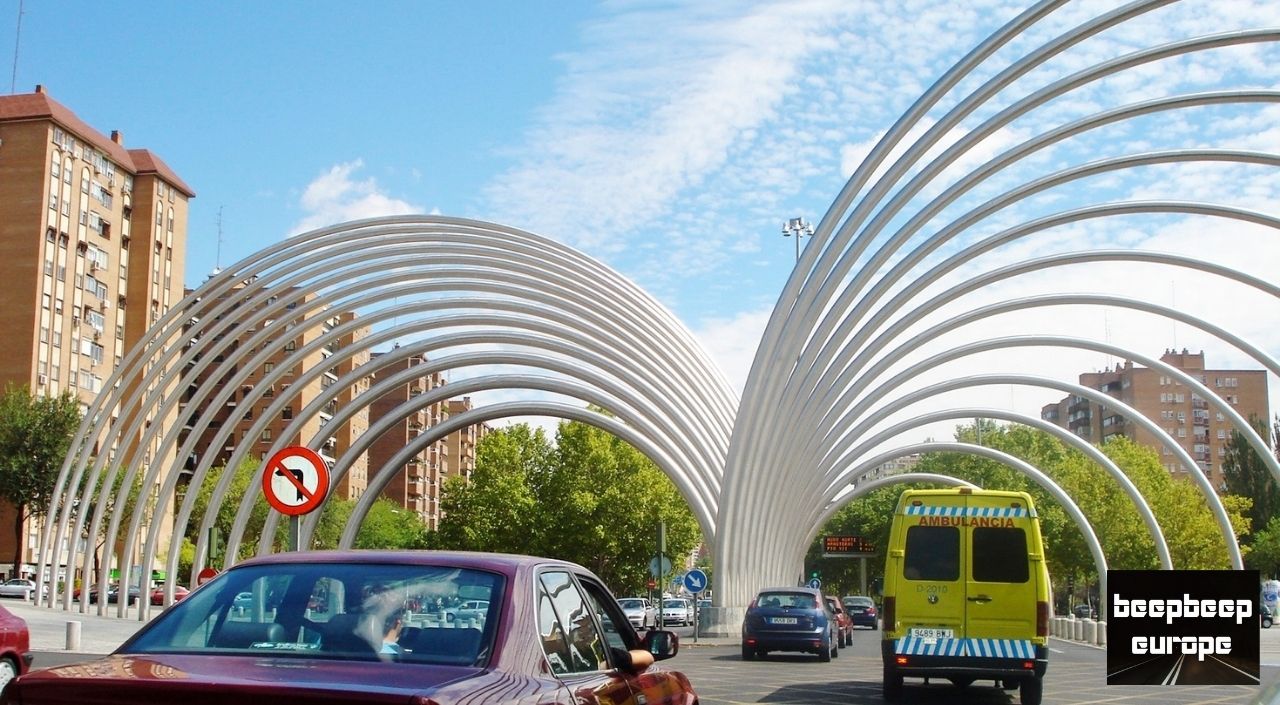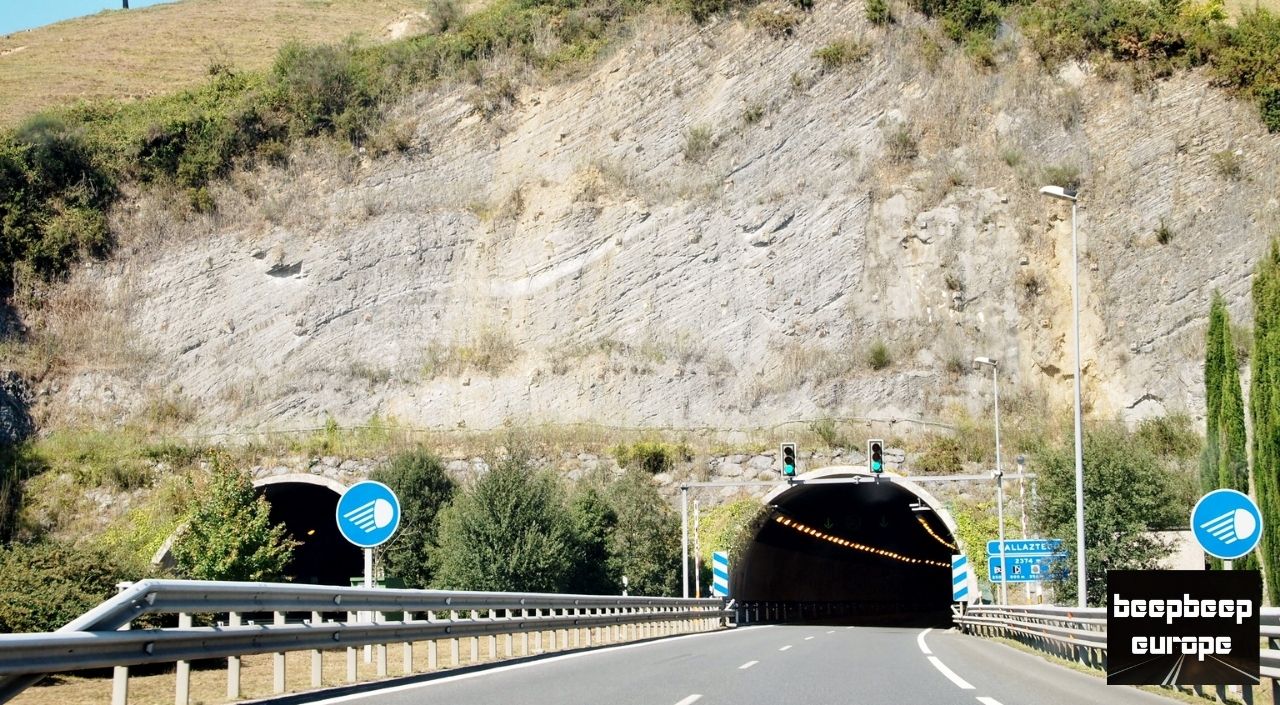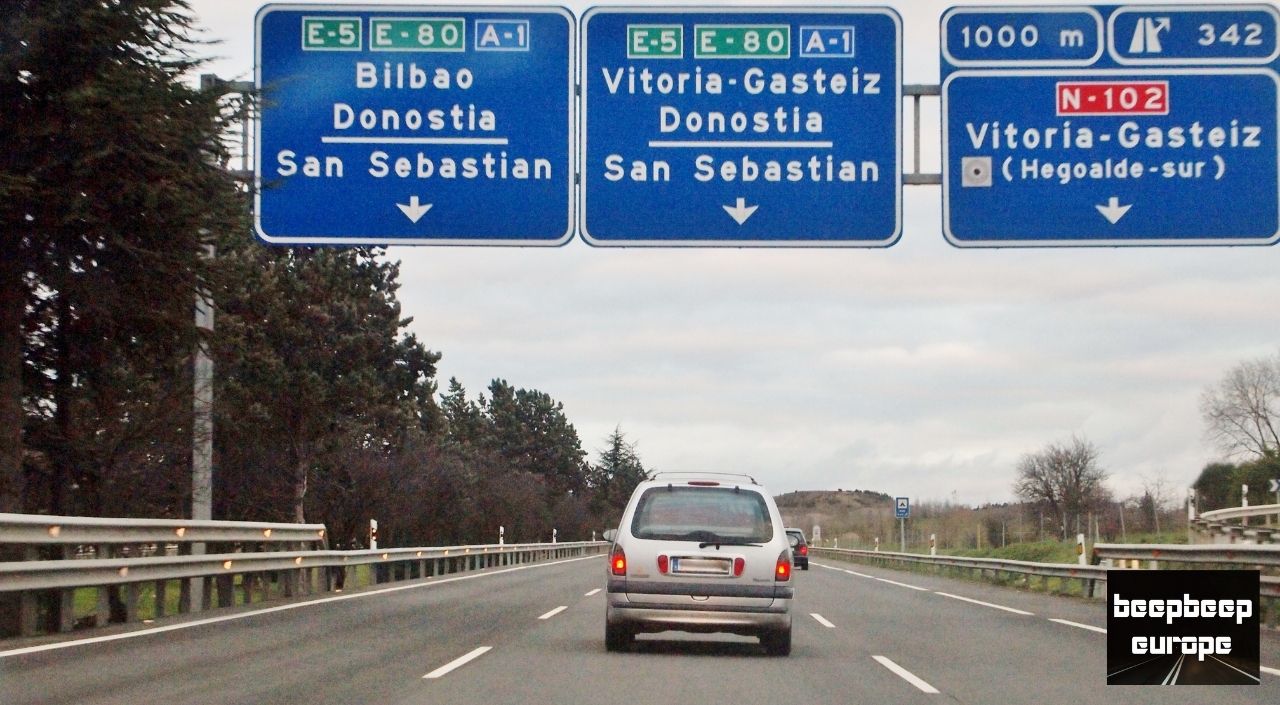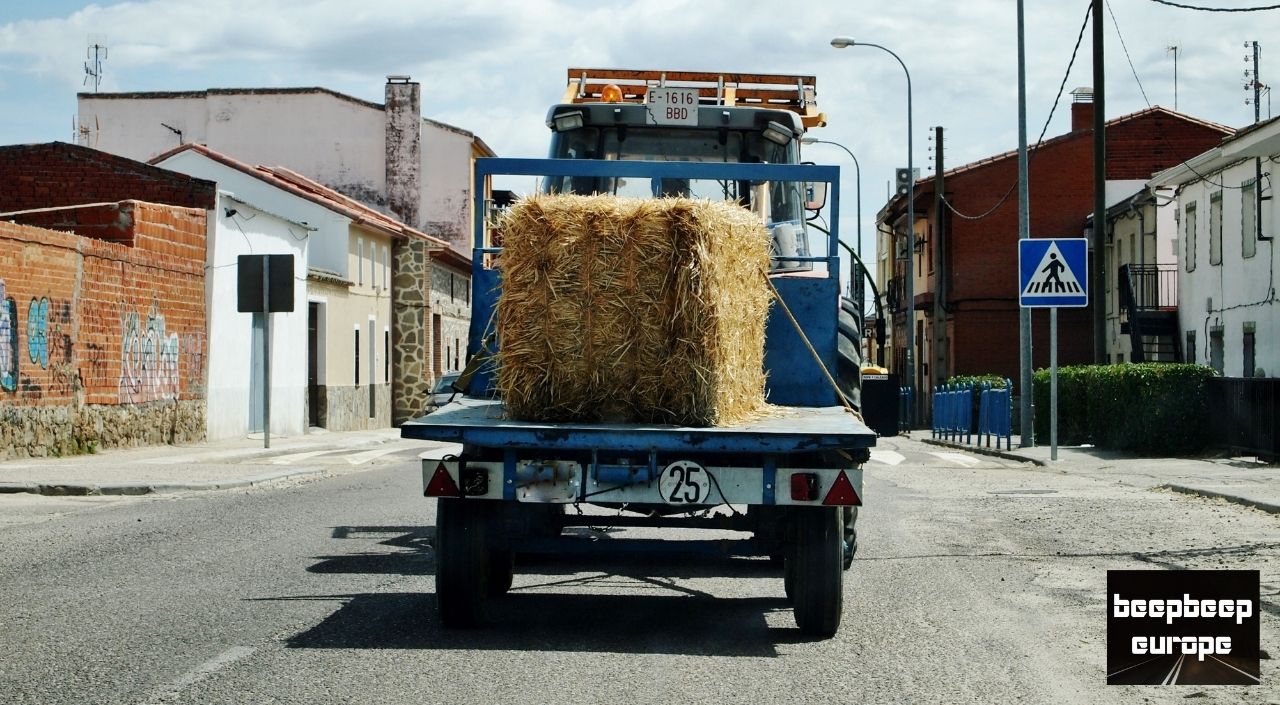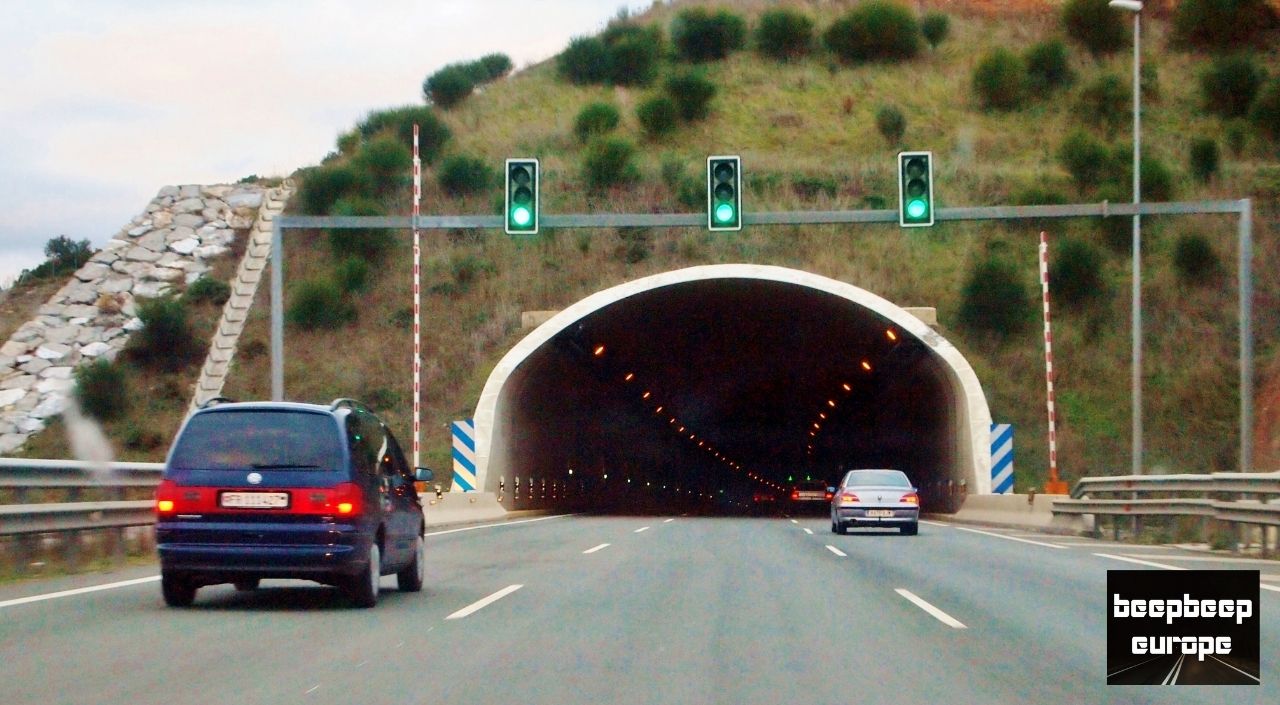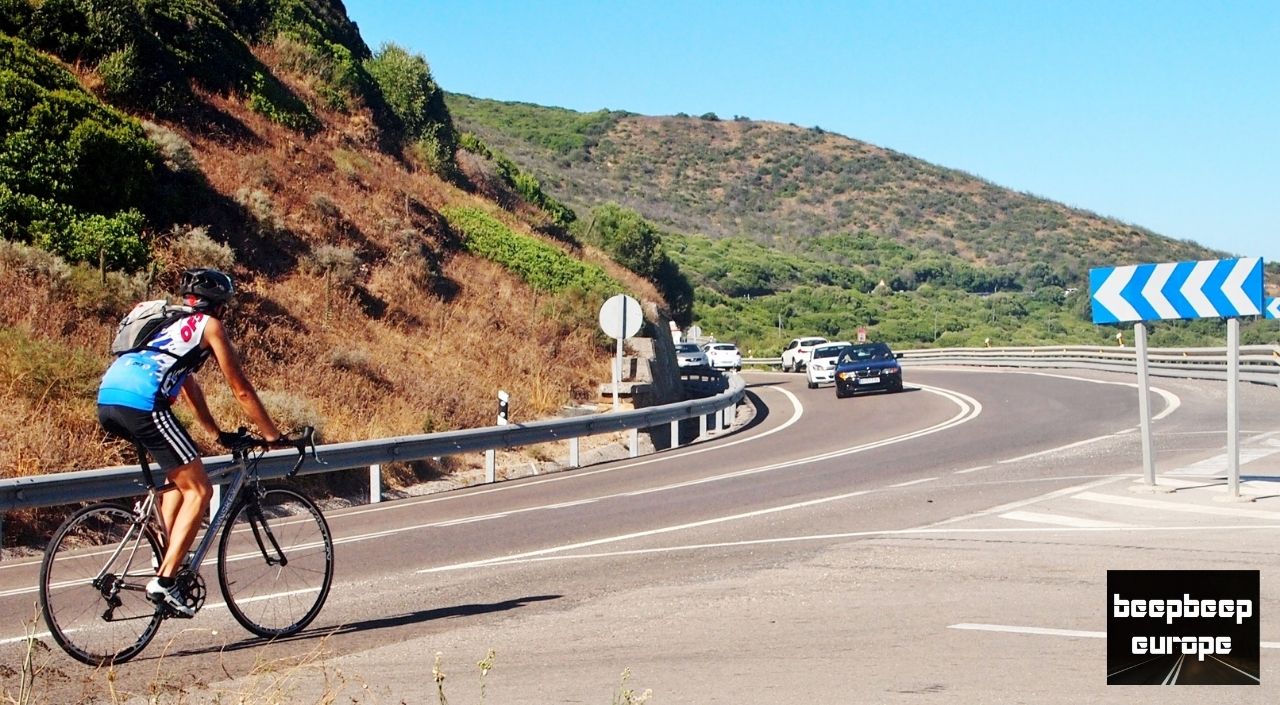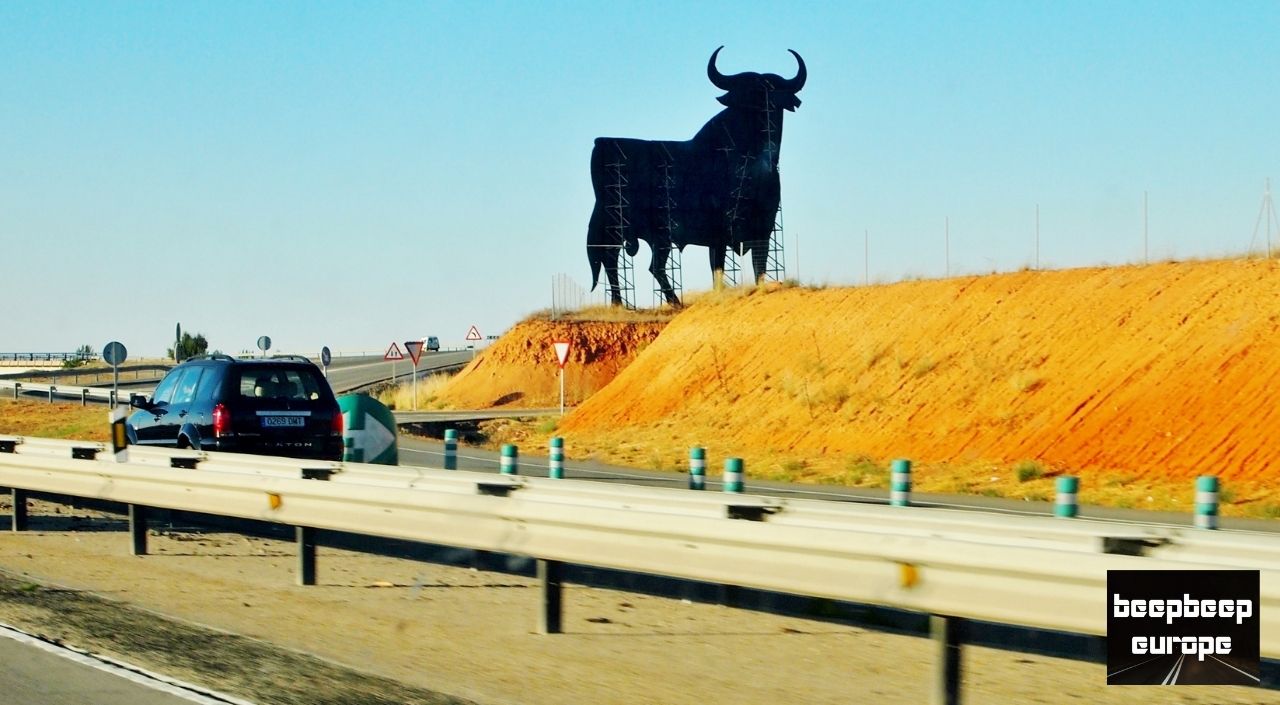Driving in Spain...
OUR ENCOUNTERS:
We have found driving through Spain a real pleasure over the years. As long as you adhere to and respect the regulations/laws like we have, it can be a fantastic roadtrip adventure. We have always felt safe and haven't really encountered any problems apart from the odd reckless driver or two. When driving through Spain we tend to drive down from San Sebastian to Madrid which takes around 5 hours, approx. 458 kms (285 miles) on the AP8/AP1 or the A1, passing by Vitoria and Burgos. The speed seems to increase as you approach Madrid, it may be to do with the heat, but you can definitely feel the madness on the outskirts and when entering.
Over the years we've noticed that there are far less trucks on the road than there has ever been. The reason for this is because the majority of drivers now use the dual carriageways which run parallel to the major motorways to avoid paying the motorway tolls. Since building the new motorway systems there has been a very heavy dip in traffic on the motorways. This has caused the dual carriageways to become very congested and if you take these roads to avoid paying the tolls, they do have their downsides. You will most likely encounter traffic jams and the busier they are the more prone to accidents they will be, your trip will also take much longer. Therefore, taking the motorways and paying the tolls is possibly the better option of the two and usually hassle free.
The roads have improved considerably over the past decade and continue to do so with ongoing construction. We have also found that there are more rest areas and petrol stations available than ever before, about every 40 kms (25 miles) or so. Years ago it was rare to find one on our journeys, there was nothing available for miles and miles and the services have also improved enormously. However, it pays to remember that unlike France the majority of these rest areas/petrol stations are not located on the actual motorway, the majority take you off into rural villages. Please note, that they are not always open 24 hours, some close for a couple
of hours during lunchtime and are also closed on Sundays. So it always pays to keep your petrol tank topped up.
We have found driving through Spain a real pleasure over the years. As long as you adhere to and respect the regulations/laws like we have, it can be a fantastic roadtrip adventure. We have always felt safe and haven't really encountered any problems apart from the odd reckless driver or two. When driving through Spain we tend to drive down from San Sebastian to Madrid which takes around 5 hours, approx. 458 kms (285 miles) on the AP8/AP1 or the A1, passing by Vitoria and Burgos. The speed seems to increase as you approach Madrid, it may be to do with the heat, but you can definitely feel the madness on the outskirts and when entering.
Over the years we've noticed that there are far less trucks on the road than there has ever been. The reason for this is because the majority of drivers now use the dual carriageways which run parallel to the major motorways to avoid paying the motorway tolls. Since building the new motorway systems there has been a very heavy dip in traffic on the motorways. This has caused the dual carriageways to become very congested and if you take these roads to avoid paying the tolls, they do have their downsides. You will most likely encounter traffic jams and the busier they are the more prone to accidents they will be, your trip will also take much longer. Therefore, taking the motorways and paying the tolls is possibly the better option of the two and usually hassle free.
The roads have improved considerably over the past decade and continue to do so with ongoing construction. We have also found that there are more rest areas and petrol stations available than ever before, about every 40 kms (25 miles) or so. Years ago it was rare to find one on our journeys, there was nothing available for miles and miles and the services have also improved enormously. However, it pays to remember that unlike France the majority of these rest areas/petrol stations are not located on the actual motorway, the majority take you off into rural villages. Please note, that they are not always open 24 hours, some close for a couple
of hours during lunchtime and are also closed on Sundays. So it always pays to keep your petrol tank topped up.
If you are thinking of driving to and around Madrid, please take care or don't - it maybe better for you to park up instead. The new dual carriageway systems are like a maze and extremely confusing. People tend to speed through them and you may find yourself driving round in circles as there are so many tunnels and connecting roads to choose from. You just need to slow down if you are unsure of your exit or what direction you need to be taking - just allow other drivers to drive past you.
When we drive from Madrid to the south, let's say Marbella it normally takes us around 5.5/6 hours, approx. 580 kms (360 miles) starting on the A4. Plus, when we drive to Portugal it takes us around 3-3.5 hours, 410 kms (255 miles) from Madrid to the border near Badajoz on the R5/A5. We have taken many other routes too and have never had a problem on any of these roads - they're in good condition and have much less traffic than they used to.
You need to pay extra attention when driving back up north to San Sebastian (Spain/France border) from Madrid as there are many signs and many different road options just past Vitoria which are confusing. We unfortunately took the wrong one a few years back via Bilbao through the mountains - it was extremely picturesque but took us much longer, eating into our schedule.
Roads signs are quite clear on motorways but not that great once you venture onto rural roads. It's always a good idea to carry a map with you as sat navs aren't great at recognising these roads either.
Unfortunately, Spain still has one of the highest number of accidents and fatality rates in Europe but it doesn't seem to be as crazy and as alarming as driving around Portugal. Some drivers are however very highly strung and inconsiderate and do not give way or slow down for anyone and will even drive on two lanes to prevent other drivers overtaking. The majority don't bother indicating either!
When we drive from Madrid to the south, let's say Marbella it normally takes us around 5.5/6 hours, approx. 580 kms (360 miles) starting on the A4. Plus, when we drive to Portugal it takes us around 3-3.5 hours, 410 kms (255 miles) from Madrid to the border near Badajoz on the R5/A5. We have taken many other routes too and have never had a problem on any of these roads - they're in good condition and have much less traffic than they used to.
You need to pay extra attention when driving back up north to San Sebastian (Spain/France border) from Madrid as there are many signs and many different road options just past Vitoria which are confusing. We unfortunately took the wrong one a few years back via Bilbao through the mountains - it was extremely picturesque but took us much longer, eating into our schedule.
Roads signs are quite clear on motorways but not that great once you venture onto rural roads. It's always a good idea to carry a map with you as sat navs aren't great at recognising these roads either.
Unfortunately, Spain still has one of the highest number of accidents and fatality rates in Europe but it doesn't seem to be as crazy and as alarming as driving around Portugal. Some drivers are however very highly strung and inconsiderate and do not give way or slow down for anyone and will even drive on two lanes to prevent other drivers overtaking. The majority don't bother indicating either!
ROAD LAWS:
1. Similar to Portugal, the Police in Spain use radar speed cameras to check speed and can issue on the spot fines (even for exceeding by just 1 kph) - these have to be paid in cash (euros) as bankcards are not accepted.
2. If you refuse to pay a fine, are under the influence of alcohol (50mg of alcohol per 100ml of blood - less than the UK), have lack of insurance cover or your car has mechanical defects, etc. it can be immobilised or be confiscated.
3. Please note there are also speed cameras dotted around Spain. Some resemble the bright yellow British ones but others are large grey boxes which are not easy to spot, so just keep within the speed limit.
4. You can now be fined if you use your mobile phone whilst driving if it's not a hands-free set, even if you are parked at the side of the road. You have to completely pull off the road away from traffic. Mobile ear devices are also banned.
5. Following a traffic accident, all drivers involved must undergo a breath test and/or saliva test for drugs.
6. If oncoming traffic flashes you, it's usually to warn you of speed traps up ahead but can also mean they want you to give them right of way in order to overtake. (Unlike Britain where we actually mean we're giving way!)
1. Similar to Portugal, the Police in Spain use radar speed cameras to check speed and can issue on the spot fines (even for exceeding by just 1 kph) - these have to be paid in cash (euros) as bankcards are not accepted.
2. If you refuse to pay a fine, are under the influence of alcohol (50mg of alcohol per 100ml of blood - less than the UK), have lack of insurance cover or your car has mechanical defects, etc. it can be immobilised or be confiscated.
3. Please note there are also speed cameras dotted around Spain. Some resemble the bright yellow British ones but others are large grey boxes which are not easy to spot, so just keep within the speed limit.
4. You can now be fined if you use your mobile phone whilst driving if it's not a hands-free set, even if you are parked at the side of the road. You have to completely pull off the road away from traffic. Mobile ear devices are also banned.
5. Following a traffic accident, all drivers involved must undergo a breath test and/or saliva test for drugs.
6. If oncoming traffic flashes you, it's usually to warn you of speed traps up ahead but can also mean they want you to give them right of way in order to overtake. (Unlike Britain where we actually mean we're giving way!)
7. You must also use your horn to warn the driver in front of your intention to overtake during the day, whereas at night you must use your headlights instead.
8. On motorways, you must indicate before overtaking and again when moving back over as you risk being fined if you are caught not doing so.
9. Spanish drivers do not tend to give way or slow down for merging traffic. Therefore, you must stop and wait for when it is clear and safe to enter when joining motorways/dual carriageways.
10. As you enter a motorway/dual carriageway from a slip road you must ensure that you do not cross the solid white line and only move over when it is intermittent.
11. When approaching an intersection you must give way to all vehicles coming from the right.
12. Drivers who are already on roundabouts have priority of way over drivers who are approaching. However do be aware of drivers who cut across you to exit a roundabout instead of moving across behind you, making it easier for them to exit. They also tend to enter a roundabout from a right lane even though they will be driving right round it to the left. (Spanish drivers are clearly not yet clued up on how to tackle large roundabouts.)
13. You are not allowed to overtake on the inside (on the right). However, do look out for drivers who do so - it is very common in Spain.
14. If you witness an accident you must safely stop to give assistance and call the emergency services on 112 (English speaking = 902 102 112). We believe it's a criminal offence if you fail to assist a person in danger.
15. Please be aware that you must switch on your lights when driving in the rain and use dipped headlights in poor daytime visibility. We believe you can be fined around 200 euros if you do not do so - but cannot confirm this for sure.
16. It is prohibited to display your sat nav on your dashboard in Spain. No devices should cover your windscreen.
17. Please be aware! - If you are stopped by the Police on the motorway/dual carriageways, put on your reflective safety vest before stepping out of the car as you may be caught out by not wearing one and be fined on the spot!
18. One of the latest regulations is that it is illegal to drive in flip flops/backless sandals as these can get stuck under the pedals. You can be fined if you are not wearing shoes which hold/strap your feet in.
19. You can also now be fined for driving through tunnels whilst wearing sunglasses.
20. You must give way to pedestrians at crossings if they show you the palm of their hand for you to stop. If you fail to stop and knock them over, you will be at fault. However, the majority of Spanish drivers still believe that cars have the right of way and refuse to stop at pedestrian crossings. So please be aware of the unclarities regarding this - we suggest you give way if it is safe to do so.
21. You can no longer sound your horn and use full beam headlights in urban/residential areas at night.
15. Please be aware that you must switch on your lights when driving in the rain and use dipped headlights in poor daytime visibility. We believe you can be fined around 200 euros if you do not do so - but cannot confirm this for sure.
16. It is prohibited to display your sat nav on your dashboard in Spain. No devices should cover your windscreen.
17. Please be aware! - If you are stopped by the Police on the motorway/dual carriageways, put on your reflective safety vest before stepping out of the car as you may be caught out by not wearing one and be fined on the spot!
18. One of the latest regulations is that it is illegal to drive in flip flops/backless sandals as these can get stuck under the pedals. You can be fined if you are not wearing shoes which hold/strap your feet in.
19. You can also now be fined for driving through tunnels whilst wearing sunglasses.
20. You must give way to pedestrians at crossings if they show you the palm of their hand for you to stop. If you fail to stop and knock them over, you will be at fault. However, the majority of Spanish drivers still believe that cars have the right of way and refuse to stop at pedestrian crossings. So please be aware of the unclarities regarding this - we suggest you give way if it is safe to do so.
21. You can no longer sound your horn and use full beam headlights in urban/residential areas at night.
MOTORWAYS:
1. Spain has improved their motorways immensely over recent years and these are payable by cash/credit cards (tarjetas) at toll booths, clearly marked just before exits. You must collect a ticket from a toll booth on entering the motorways.
2. If you do get lost or miss your exit, you will come across slip roads signposted 'Cambio de Sentido' every so often which will allow you to change direction.
3. If you have been involved in an accident or broken down you will find Emergency Telephones (orange posts) around every 5 kms (3 miles) or so. These are all numbered and will connect you to the local Police. They will send out a Rescue Service (Auxilio en Carretera)/Breakdown Recovery Truck (Grua). Try to park up on the roadside or on the hard shoulder if possible.
4. Spain also offers the Via-T & Bi-Model motorway systems which automatically scan devices fitted to windscreens/licence plates. These are rented and paid for on a monthly basis offering the users discounted toll rates as well as the benefit of driving through designated lanes instead of having to queue up. These devices can also be used in France and Portugal - but you will need to look into this in more detail (they could be a good option if you are a frequent traveller).
5. You should not drive through these designated lanes if you do not have one of these devices.
1. Spain has improved their motorways immensely over recent years and these are payable by cash/credit cards (tarjetas) at toll booths, clearly marked just before exits. You must collect a ticket from a toll booth on entering the motorways.
2. If you do get lost or miss your exit, you will come across slip roads signposted 'Cambio de Sentido' every so often which will allow you to change direction.
3. If you have been involved in an accident or broken down you will find Emergency Telephones (orange posts) around every 5 kms (3 miles) or so. These are all numbered and will connect you to the local Police. They will send out a Rescue Service (Auxilio en Carretera)/Breakdown Recovery Truck (Grua). Try to park up on the roadside or on the hard shoulder if possible.
4. Spain also offers the Via-T & Bi-Model motorway systems which automatically scan devices fitted to windscreens/licence plates. These are rented and paid for on a monthly basis offering the users discounted toll rates as well as the benefit of driving through designated lanes instead of having to queue up. These devices can also be used in France and Portugal - but you will need to look into this in more detail (they could be a good option if you are a frequent traveller).
5. You should not drive through these designated lanes if you do not have one of these devices.
PARKING:
1. You must park in the same direction as the traffic (the right hand side) on roads with two-way traffic lanes.
2. Do check the Parking Signs for local parking restrictions as these may vary throughout the country from Pay and Display, Blue Parking Zones to Parking Meters and Automatic Machines. Some machines now accept bankcards.
3. In certain areas Parking Restrictions apply to one side of the road for the first half of the month and on the other side for the second half of the month. In some areas parking is restricted to odd numbers on one day and even numbers on another - so please double-check restrictions carefully.
4. If you park illegally your car may be towed away. A sticker will be placed on the pavement advising you this has happened. You must then visit the Compound (as detailed on the sticker), pay the recovery fees and then you must visit the nearest Police Station to pay the fine and once again visit the Compound to collect your car. As well as it being a nightmare retrieving your car, it can also be very expensive and something you can do without whilst on your travels, so it always pays to check the Parking Restrictions properly.
5. It is also better and safer to park in a Car Park if you are unsure of the Parking Restrictions. Sometimes it's worth paying that little bit extra.
6. Never park next to a pavement kerb painted in yellow.
7. Parking is normally free on Sundays and Bank Holidays.
8. British Disabled Parking Permits are recognised in Spain - your permit must be displayed clearly on the inside of your windscreen whilst parking.
9. Just because the Spanish park every which way - it doesn't mean you can!
1. You must park in the same direction as the traffic (the right hand side) on roads with two-way traffic lanes.
2. Do check the Parking Signs for local parking restrictions as these may vary throughout the country from Pay and Display, Blue Parking Zones to Parking Meters and Automatic Machines. Some machines now accept bankcards.
3. In certain areas Parking Restrictions apply to one side of the road for the first half of the month and on the other side for the second half of the month. In some areas parking is restricted to odd numbers on one day and even numbers on another - so please double-check restrictions carefully.
4. If you park illegally your car may be towed away. A sticker will be placed on the pavement advising you this has happened. You must then visit the Compound (as detailed on the sticker), pay the recovery fees and then you must visit the nearest Police Station to pay the fine and once again visit the Compound to collect your car. As well as it being a nightmare retrieving your car, it can also be very expensive and something you can do without whilst on your travels, so it always pays to check the Parking Restrictions properly.
5. It is also better and safer to park in a Car Park if you are unsure of the Parking Restrictions. Sometimes it's worth paying that little bit extra.
6. Never park next to a pavement kerb painted in yellow.
7. Parking is normally free on Sundays and Bank Holidays.
8. British Disabled Parking Permits are recognised in Spain - your permit must be displayed clearly on the inside of your windscreen whilst parking.
9. Just because the Spanish park every which way - it doesn't mean you can!
HANDY INFO:
Emergency number: 112 (091-Police / 061-Ambulance / 080-Fire)
Dialling code: 00 34
Currency: Euro
Time difference: Spanish time is one hour ahead of the UK (GMT)
Speed limits:
Urban/built-up areas: 20-50 kmh (12-31 mph) - as indicated
Open/country roads: 90 kmh (56 mph)
Dual carriageways: 80-110 kmh (50-68 mph) - as indicated
Motorways: 120 kmh (75 mph)
Fuel (Unleaded) = Gasolina (95 or 98 Octane - Sin plomo)
Diesel = Diesel/Gasoleo
Motorways (AP-Autopistas) with Tolls: There are toll booths clearly marked which can be paid for by cash/bankcards. The most expensive route is probably from the French border (La Junquera) to Alicante costing in total around 60 euros.
Dual carriageways (Autovias) Toll free: A, C, E, M (Madrid), N & R (Radial - Madrid circulars) - please note there are however a small number of A, C & R roads which have tolls too.
Emergency number: 112 (091-Police / 061-Ambulance / 080-Fire)
Dialling code: 00 34
Currency: Euro
Time difference: Spanish time is one hour ahead of the UK (GMT)
Speed limits:
Urban/built-up areas: 20-50 kmh (12-31 mph) - as indicated
Open/country roads: 90 kmh (56 mph)
Dual carriageways: 80-110 kmh (50-68 mph) - as indicated
Motorways: 120 kmh (75 mph)
Fuel (Unleaded) = Gasolina (95 or 98 Octane - Sin plomo)
Diesel = Diesel/Gasoleo
Motorways (AP-Autopistas) with Tolls: There are toll booths clearly marked which can be paid for by cash/bankcards. The most expensive route is probably from the French border (La Junquera) to Alicante costing in total around 60 euros.
Dual carriageways (Autovias) Toll free: A, C, E, M (Madrid), N & R (Radial - Madrid circulars) - please note there are however a small number of A, C & R roads which have tolls too.
For more beepbeepeurope tips & stories
Photography: beepbeepeurope
© Copyright. All rights reserved.
© Copyright. All rights reserved.
